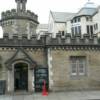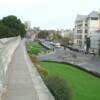
A quick visit to York
reputedly from the Old English Eoforwīc, which means "wild-boar town", and then popularly modified to the Norse Jórvík meaning "horse bay." I recommend Wikipedia for the bigger picture
After our canal trip we spent a short while in York, it seemed a pity to get so close and not to spend a while in such an historic city. I'd never been there before and had my metaphorical socks appropriately blown off. I could see why the occasional North American was somewhat stunned. The sign on the right to St Peter's School was just a few yards up the road from our hotel, it puts history into perspective.
(Click the pictures to magnify them.)
There are so many historic, very nearly pre-historic, buildings in York that the local population have to live in them, otherwise there wouldn't be enough room for them to live. In newer places any old building is turned into a museum in it's own right, or a display case for some art forms, or council offices if the local council has an adequately brazen neck. These conversions are usually awkward, inapropriate and ridiculously expensive. In York the buildings, no doubt, have horrendous restrictions placed on their modification, but they are in use by ordinary people rather than being turned into dry and inaccessable monuments. The result is that some are now shops and businesses, like the sandwich shop opposite.
As Brighton has "The Lanes" York has The Shambles. Unfortunately a lot of the little shops have been bought up by rather high profit businesses. These target a fairly well heeled clientel, who in turn require bright clean shiny things that can be bought in the fashionable section of any major city, Profitable McDonalds or Pizza Hut franchises can out-bid scruffy little bookshop owners and pay the high council rates charged on such properties, but the result is eccentric little shops with flagship multinational businesses wedged in, and a high street full of building societies and solicitors in tiny offices. Unlikely to attract money laden tourists.
It is similar to the 'last house' problem, where the person who built the latest house in a picturesque village says that it would be a mistake to build any more, as that would spoil the ambiance of the village. So the attractiveness of an old town is wrecked by the multinationals who know that their profits will be magnified by being in a site of historic interest, until it isn't because of all the multinationals squeezing out the historic, quaint and interesting.
My home town, Winchester, suffered the same fate and for a while the High Street was full of banks and shoe shops, fortunately they seem to have pulled back from the brink.
There's still a huge collection of really big stuff, like ancient water towers, city walls, churches and derelict Cathedrals, museums, exhibitions and odd bits of masonry. There's enough for several days, so take a few and do it slow. Wikipedia has loads of detail on the place,
Click to expand thumbnail picture

